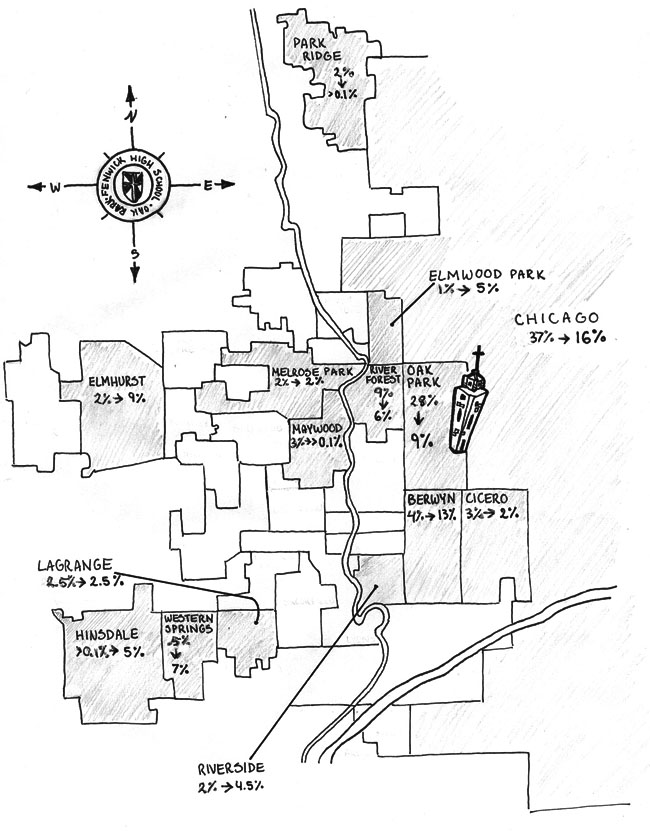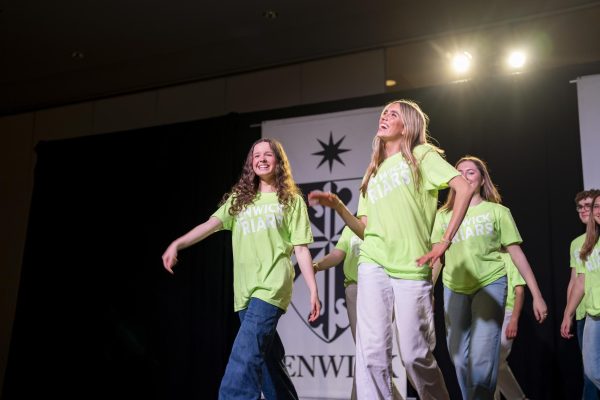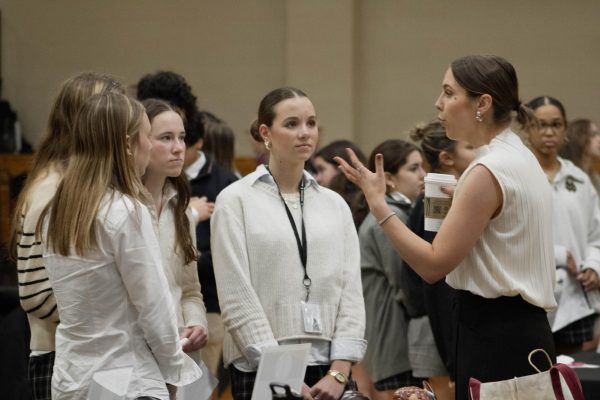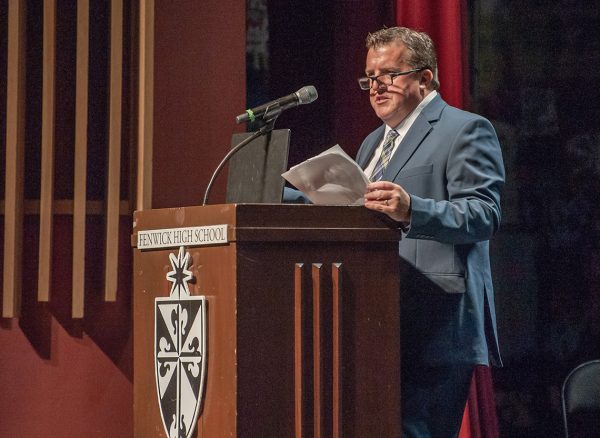Fenwick at 90: Examining the Past, Facing the Future
Whence the Friars: Change in percentages of students from 14 major communities from 1939-40 to the 2018-19 school year. Illustration by Natalia Dabrowska
MISSION
Almost ninety years ago, Fenwick first opened its doors. Since then, the school has found the balance between adapting with the changing times and retaining principles from its very first years.
As President Fr. Richard Peddicord stated, “Fenwick has always stood for academic excellence and providing its students with the preparation that’s necessary for a successful college experience. It has done this, as our mission statement says, ‘guided by Dominican Catholic values.’
“In the last several decades, we’ve more consciously recognized the value of diversity and have embraced the ideal of being an inclusive community. We’re accomplishing this day by day while remaining true to our identity as a Dominican school.”
CONSTRUCTION
When the archbishop looked at 1920s Chicago, he saw an opportunity. In the area around Oak Park,
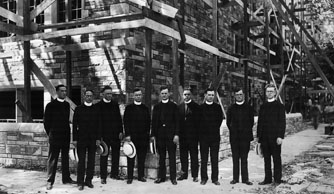
Fenwick Archives Photo
the only Catholic high school, Trinity, was exclusively for girls; so when the Dominicans approached him wanting to construct a seminary, he agreed under the condition that they also start a boys’ high school.
Oak Park was a largely protestant area, so establishing a Catholic high school helped to spread Catholicism in the Midwest.
In 1928, the Dominicans obtained seven lots along Washington Boulevard, extending from East Avenue to Scoville, and construction began in November of the same year.
The land had previously been occupied by the Cusack house (pictured in the bottom right corner), which was retained during construction and became Fenwick’s first priory.
Construction was completed in the next nine months and the cornerstone was blessed on August 13, 1929. The final product was a building reminiscent of Gothic architecture, with the exterior being made of stones brought in from a quarry in Massachusetts.
FIRST DAY OF SCHOOL
Fenwick first opened its doors on September 9th, 1929, when 200 boys, mostly freshmen, walked through the arched doors on Washington.
The first faculty was comprised of eleven Dominican Friars, who taught multiple subjects and several classes of students. Among them was Fenwick’s first principal Rev. L. C. Gainor, O. P..
Just six weeks after the first day of school, the stock market crashed, lurching the country into the decade known as the Great Depression.
Faculty and students reacted accordingly, with families having to make sacrifices so their boys could stay in school. Many Fenwick students, however, had to halt their education and work to support their families.
One such student was Joseph Ori, who was part of Fenwick’s first class. After two years, Ori dropped out to work with his father at the produce mart. He helped to support the Ori family during these difficult times. Years down the road, his son, Joseph Ori II, would go on to graduate in 1961. The third of the Joseph Oris graduated in 2003, and now works in admissions. His newborn son, he hopes, will be the fourth Joseph Ori to attend Fenwick.
The story of the Oris attests to the durability of the Fenwick spirit. The third Joseph Ori says that, “The key [to Fenwick’s reputation] is that all the kids are bright and motivated–then, the school is boundless to the potential of their success.” Through years, Fenwick stands with the same sense of dignity that it displayed on that first day of school.
2nd GENERATION
Through the 1940s and ‘50s, the Fenwick community evolved into a prominent boys’ Catholic school in the Chicagoland area. The student population rose steadily through the decades and increased in diversity as students began to come from a variety of suburbs.
By 1960, Fenwick had graduated its first black student, a Maywood resident, Richard Cochrane of the Class of ‘59. Cochrane was the first black student at Fenwick, and he was the only black student in the building for his entire four years.
Cochrane started his freshman year in 1955, one year after the monumental Brown v. Board of Education, which declared the establishment of separate schools for blacks and whites unconstitutional.
The Dominican community supported Cochrane throughout his time at Fenwick, and he reflects happily on his high school days.
Despite racial tension at the time of his enrollment, Cochrane felt the support that came from the majority of the student body and faculty outweighed any minority group that was hostile or distance towards him.
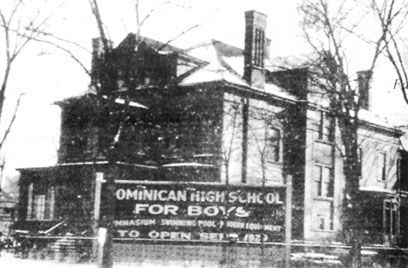
Photo courtesy of Fenwick
In an interview for an Alumni Spotlight, Cochrane emphasized, “The single greatest factor was the Dominican community. I got the feeling that they would not let me fail (or even consider quitting).”
With the graduation of the first black student in 1959, the 1960’s began a new era in Fenwick’s history. During that tumultuous decade, the auditorium was built, the student body celebrated its first homecoming, and the Blackfriars Guild performed the first Banua. By the end of the decade, Fenwick celebrated its 50th anniversary.
1992
The 1990s brought a wave of changes to Fenwick. With the commencement of a new decade, talk of going coed began to spread around the school, and with it, several opinions. In a 1990-1991 yearbook poll, the split was evident– 48% of the student body was in favor of the change, and 49% was against it.
In December of 1990, a letter was sent to the parents of all Fenwick students, announcing that the Board of Trustees had approved the switch to coeducation and that young women would be able to enroll sometime in the near future.
The future brought female students to Fenwick for the 1992-1993 school year. Among the first women of Fenwick was Ms. Samantha Carraher. She, like many other girls in her class, was excited for the opportunity to attend Fenwick because her father had graduated years before.
To the first young women of Fenwick, it was about retaining tradition, continuing a legacy, and paving a new path for the future.
PRESENT
Today, Fenwick is proud to draw from more than just the surrounding areas. Fenwick now draws from 172 different grade schools, and over 60 different towns and villages.
In addition, the student body is now 30% non-caucasian, and is equally male and female.
Many things have changed since our founding in 1929, but there have been many constants. The students have always been friars, in many ways.
As Fr. Peddicord says, “All of our students are striving to be Friars—to espouse the values of Fenwick and to do their part in ‘leading, achieving, and serving.’ This is what makes Fenwick students so special: they work to be part of this great community and make a contribution to its 90-year tradition.
“Also, they realize the truth of the saying, ‘once a Friar, always a Friar.’ They’re willing to support each other during their four years here and with remain committed to each other throughout their lives.”
FUTURE
As Fenwick continues to diversify its student body in race and community, a future full of varied opinions and creeds can be expected.
In addition, as times change and resources valuable to the learning environment develop, the school expects to stay modernized. Fr. Peddicord said, “We’re in the midst of our Centennial Capital Campaign. I see a future for Fenwick where all our facilities reflect the excellence of our Faculty, our curriculum, and our student’s accomplishments. Also, I can see the day when our endowment for student scholarships is large enough that our mission is sustained through our second century.”
The future of Fenwick is bright, but this light will not blind us from reflecting on our past. The school thrives because it learns how to move forward from the past while retaining classic values.



